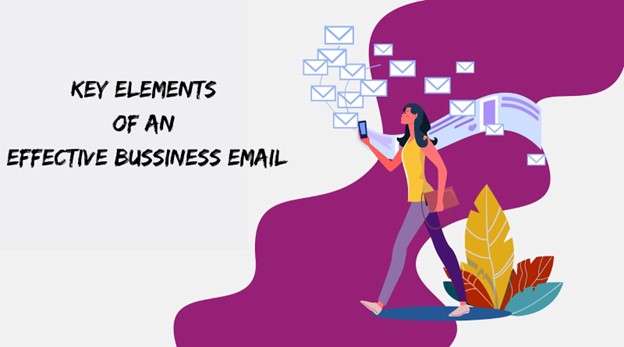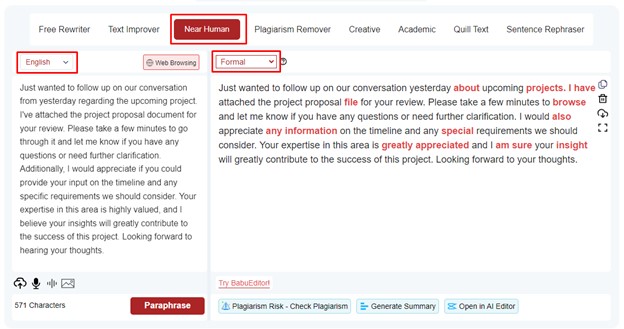How to write effective business emails?

Welcome to beginners, looking for a method of writing an effective business email.
Writing a business email means you are preparing a professional proposal. So, it will be far different from sending an email to your friend or an institute.
Paraphrasers have made it easier to prepare a captivating email body for business emails.
We will discuss today the key elements of a business email and how a paraphrasing tool can help write it.
What is a Business Email & What is Its Purpose?
A business email is a formal electronic communication sent within a professional setting. Or a written message exchanged between individuals or groups within an organization or between different organizations.
The purpose of a business email is to facilitate efficient and effective communication professionally. It serves several purposes, including:
Information Sharing:
Business emails aim to share important information, updates, and reports with colleagues, clients, or stakeholders.
Collaboration Proposal:
Emails enable collaboration among team members. It allows them to discuss projects, share ideas, provide feedback, and coordinate tasks.
Decision Making:
Business emails often are a medium for decision-making processes, where proposals or requests are presented and discussed.
Requesting or Providing Information:
Emails are commonly used to request or provide specific information. It may be about products or services, seeking clarification, or sharing data and resources.
Relationship Building:
Business emails contribute to building and nurturing professional relationships. It is a way of expressing gratitude, extending invitations, or initiating conversations with potential clients, partners, or colleagues.
Formal Communication:
Emails provide a formal means of communication, allowing for documentation and record-keeping purposes. It ensures accountability and maintains professionalism in business interactions.
Key Elements of an Effective Bussiness Email
By paying attention to these key elements, you can enhance the effectiveness of your business emails.
1. Recipient/s
Identifying the right recipient/s is crucial for ensuring that your email reaches the intended audience.
Consider who needs to be included based on their role, expertise, or decision-making authority.
2. Subject Line
The subject line serves as the first impression and determines whether your email gets opened or ignored.
A concise and compelling subject line should accurately summarize the purpose of your email and entice the recipient to open it. For example:
- Meeting Request: Discussing Marketing Strategy
- Proposal Submission: New Product Launch Campaign
- Urgent Action Required: Updated Sales Figures Needed
- Invitation: Networking Event for Industry Professionals
- Follow-up: Meeting Recap and Action Items
3. Greetings
Begin your email with a professional and appropriate greeting. You can use:
- Dear Mr. Johnson,
- Hello Team,
- Hi Emily,
- Good morning, Dr. Rodriguez,
- Dear Hiring Manager,
Greetings will be adjusted according to your relationship with the recipient. The type of relationship will also determine the level of formality required in greetings.
4. Email Body
The email body contains a brief detail of the objective of your email. It should be concise, clear, and organized.
Use short paragraphs or bullet points to improve readability. Clearly state your purpose and provide relevant details, supporting information, or instructions.
Paraphrasing tools are effective for preparing or rephrasing the body of business emails.
Paraphrasingtool.ai features “Near Human” rewriting mode, best for rewording the body of the email. Moreover, it has 4 writing tone options and 30 languages to write in.
For example:
5. Call to Action (CTA)
Near the end of a business email, it is crucial to include a clear and specific call to action. You can include a timeline if applicable. For example:
“Please review the attached proposal and provide your feedback by Friday, June 25th. Kindly let me explain if you want further clarification or have any questions. I will be waiting for your response.”
Sentence Rephraser of the Paraphrasingtool.ai provides 10 alternate sentence suggestions. These can be highly useful in rewriting the same CTA for multiple emails:
Remember that emails can be easily misinterpreted if there is any ambiguity. And the call to action should leave no room for confusion regarding your request.
Avoid assuming that the reader understands the desired result based on prior information. Make sure to state the specific action you want the recipient to take.
PS: In case you are sending the email to multiple recipients, always clarify task responsibilities by directly naming the intended person. A detailed clarification of the tasks or expectations will enable the recipient to respond more effectively.
6. Closing Message
Conclude your email with a professional closing message. It should be a polite phrase and as brief as possible. You can use phrases such as:
- Thank you
- Looking forward to your response
- Please consider my request
- Kind regards followed by your name
It adds a polite and personal touch to your communication.
7. Attachments & Links
If necessary, attach relevant documents or include links to additional resources to provide further information or support your message.
Name the files or mention the document title in parentheses immediately after referring to them in the email.
Also, double-check the inserted link to make sure that it opens the right file or site. Let’s have an example for inserting a link or attachment:
“I have found an insightful article related to our ongoing project. You can find it at the following link: [insert link]. It provides valuable insights that could help us refine our strategy. Share your thoughts once you check it out.”
8. Revision
Before hitting the send button, proofread your email for grammar, spelling, and clarity.
Double-check all the details, including names, dates, and any attachments or links.
Taking a moment to review and revise ensures that your email appears professional and error-free.
Example of an Effective Business Email
Final Verdict:
Mastering the art of writing effective business emails is a valuable skill that can significantly impact your professional success.
In today’s digital business world, the ability to convey your message professionally through email is essential.
Effective business emails can foster stronger professional relationships, improve collaboration, and drive successful outcomes.
So, to win new clients, secure partnerships, or simply enhance internal communication, our unparalleled guide will undoubtedly give you a competitive edge.





